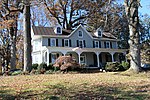Maryland's 7th congressional district
1793 establishments in MarylandCongressional districts of MarylandConstituencies established in 1793Data missing from February 2020Data missing from January 2021 ... and 1 more
Use mdy dates from April 2021

Maryland's 7th congressional district of the United States House of Representatives encompasses almost the entire city of Baltimore and some of Baltimore County. The district was created following the census of 1790, which gave Maryland one additional representative in the House. It was abolished in 1843 but was restored in 1950 as a west Baltimore district. It has been drawn as a majority-African American district since 1973. Democrat Kweisi Mfume is the current representative, winning a special election on April 28, 2020, to finish the term of Elijah Cummings, who died in October 2019. Mfume had previously held the seat from 1987 to 1996.
Excerpt from the Wikipedia article Maryland's 7th congressional district (License: CC BY-SA 3.0, Authors, Images).Maryland's 7th congressional district
Resort Road,
Geographical coordinates (GPS) Address Nearby Places Show on map
Geographical coordinates (GPS)
| Latitude | Longitude |
|---|---|
| N 39.3 ° | E -76.9 ° |
Address
Resort Road 11199
21042
Maryland, United States
Open on Google Maps




